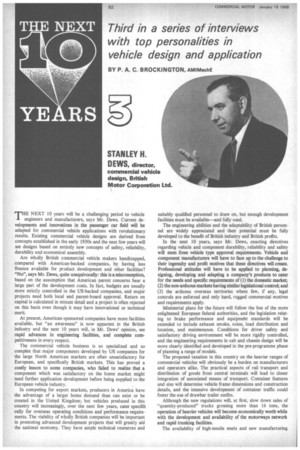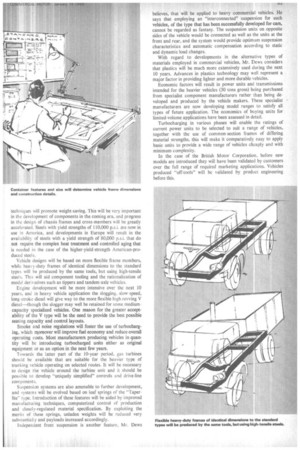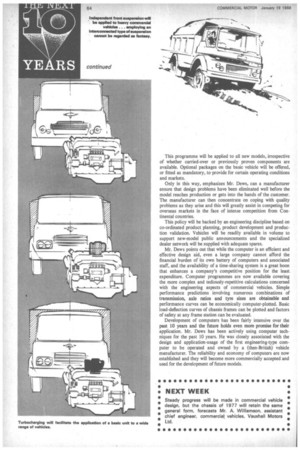BY P. A. C. BROCKINGTON,AmonechE
Page 64

Page 65

Page 66

If you've noticed an error in this article please click here to report it so we can fix it.
THE NEXT 10 years will be a challenging period to vehicle engineers and manufacturers, says Mr. Dews. Current developments and innovations in the passenger car field will be adapted for commercial vehicle applications with revolutionary results. Existing commercial vehicle designs are derived from concepts established in the early 1930s and the next few years will see designs based on entirely new concepts of safety, reliability, durability and economical assembly.
Are wholly British commercial vehicle makers handicapped, compared with American-backed companies, by having less finance available for product development and other facilities? "No", says Mr. Dews, quite unequivocally: this is a misconception, based on the assumption that American parent concerns bear a large part of the development costs. In fact, budgets are usually more strictly controlled in the US-backed companies, and major projects need both local and parent-board approval. Return on capital is calculated in minute detail and a project is often rejected on this basis even though it may have innovational or technical merit.
At present, American-sponsored companies have more facilities available, but "an awareness" is now apparent in the British industry and the next 10. years will, in Mr. Dews' opinion, see rapid advances in engineering facilities, and complete competitiveness in every respect.
The commercial vehicle business is so specialized and so complex that major components developed by US companies for the large North American markets are often unsatisfactory for European, and specifically British markets. This has proved a costly lesson to some companies, who failed to realize that a component which was satisfactory on the home market might need further application development before being supplied to the European vehicle industry.
In competing for export markets, producers in America have the advantage of a larger home demand than can exist or be created in the United Kingdom; but vehicles produced in this country will increasingly, over the next few years, cater specifih cally for overseas operating conditions and performance requirements. The viability of wholly British companies will be important in promoting advanced development projects that will greatly aid the national economy. They have ample technical resources and suitably qualified personnel to draw on, but enough development facilities must be available—and fully used.
The engineering abilities and the adaptability of British personnel are widely appreciated and their potential must be fully developed to the benefit of British industry and British profits.
In the next 10 years, says Mr. Dews, exacting directives regarding vehicle and component durability, reliability and safety will stem from vehicle type approval requirements. Vehicle and component manufacturers will have to face up to the challenge to their ingenuity and profit motives that these directives will create. Professional attitudes will have to be applied to planning, designing, developing and adapting a company's products to cater for the needs and specific requirements of (1) the domestic market; (2) the non-arduous markets having similar legislational control; and (3) the arduous overseas territories where few, if any, legal controls are enforced and only hard, rugged commercial motives and requirements apply.
Ministerial plans for the future will follow the line of the more enlightened European federal authorities, and the legislation relating to brake performance and equipment standards will be extended to include exhaust smoke, noise, load distribution and location, and maintenance. Conditions for driver safety and satisfactory driving environment will be more rigidly controlled, and the engineering requirements in cab and chassis design will be more clearly identified and developed in the pre-programme phase of planning a range of models.
The proposed taxation in this country on the heavier ranges of commercial vehicles will obviously be a burden on manufacturers and operators alike. The practical aspects of rail transport and distribution of goods from central terminals will lead to closer integration of associated means of transport. Container features and size will determine vehicle frame dimensions and construction details, and the intensive development of container traffic could foster the use of drawbar trailer outfits.
Although the new regulations will, at first, slow down sales of "quantity-produced" trucks grossing more than 16 tons, the operation of heavier vehicles will become economically worth while with the development and availability of the motorways network and rapid trunking facilities.
The availability of high-tensile steels and new manufacturing techniques will promote weight-saving. This will be very important in the development of components in the coming era, and progress in the design of chassis frames and cross-members will be greatly accelerated. Steels with yield strengths of 110,000 p.s.i. are now in use in America, and developments in Europe will result in the availability of steels with a yield strength of 80,000 p.s.i. that do not require the complex heat treatment and controlled aging that is needed in the case of the higher-yield-strength American-produced steels.
Vehicle designs will be based on more flexible frame members, while heavy-duty frames of identical dimensions to the standard types will be produced by the same tools, but using high-tensile steels. This will aid component tooling and the rationalization of model derivatives such as tippers and tandem-axle vehicles.
Engine development will be more intensive over the next 10 years, and in heavy vehicle application the slogging, slow-speed, long-stroke diesel will give way to the more flexible high-revving V diesel—though the slogger may well be retained for some mediumcapacity specialized vehicles. One reason for the greater acceptability of the V type will be the need to provide the best possible seating capacity and control layouts.
Smoke and noise regulations will foster the use of turbocharging, which nioreover will improve fuel economy and reduce overall operating costs. Most manufacturers producing vehicles in quantity will be introducing turbocharged units either as original equipment or as an option in the next few years.
Towards the latter part of the 10-year period, gas turbines should be available that are suitable for the heavier type of trunking vehicle operating on selected routes. It will be necessary to design the vehicle around the turbine unit and it should be possible to develop "uniquely simplified" controls and drive-line components.
Suspension systems are also amenable to further development, and systems will be evolved based on leaf springs of the "Taperlite" type. Introduction of these features will be aided by improved manufacturing techniques, computerized control of production and closely-regulated material specification. By exploiting the merits of these springs, unladen weights will he reduced very substantially and payloads increased accordingly.
Independent front suspension is another feature, Mr. Dews believes, that will be applied to heavy commercial vehicles. He says that employing an "interconnected" suspension for such vehicles, of the type that has been successfully developed for cars, cannot be regarded as fantasy. The suspension units on opposite sides of the vehicle would be connected as well as the units at the front and rear, and the system would provide optimum suspension characteristics and automatic compensation according to static and dynamic load changes.
With regard to developments in the alternative types of materials employed in commercial vehicles, Mr. Dews considers that plastics will be much more extensively used during the next 10 years. Advances in plastics technology may well represent a major factor in providing lighter and more durable vehicles.
Economic factors will result in power units and transmissions intended for the heavier vehicles (30 tons gross) being purchased from specialist component manufacturers rather than being developed and produced by the vehicle makers. These specialist manufacturers are now developing model ranges to satisfy all types of future application. The economics of buying units for limited-volume applications have been assessed in detail.
Turbocharging in various phases will enable the ratings of current power units to be selected to suit a range of vehicles, together with the use of common-section frames of differing material strengths, this will make it comparatively easy to apply basic units to provide a wide range of vehicles cheaply and with minimum complexity.
In the case of the British Motor Corporation, before new models are introduced they will have been validated by customers over the full range of required marketing applications. Vehicles produced "off-tools" will be validated by product engineering before this. This programme will be applied to all new models, irrespective of whether carried-over or previously proven components are available. Optional packages on the basic vehicle will be offered, or fitted as mandatory, to provide for certain operating conditions and markets.
Only in this way, emphasizes Mr. Dews, can a manufacturer ensure that design problems have been eliminated well before the model reaches production or gets into the hands of the customer. The manufacturer can then concentrate on coping with quality problems as they arise and this will greatly assist in competing for overseas markets in the face of intense competition from Continental countries.
This policy will be backed by an engineering discipline based on co-ordinated product planning, product development and production validation. Vehicles will be readily available in volume to support new-model public announcements and the specialized dealer network will be supplied with adequate spares.
Mr. Dews points out that while the computer is an efficient and effective design aid, even a large company cannot afford the financial burden of its own battery of computers and associated staff, and the availability of a time-sharing system is a great boon that enhances a company's competitive position for the least expenditure. Computer programmes are now available covering the more complex and tediously-repetitive calculations concerned with the engineering aspects of commercial vehicles. Simple performance predictions involving numerous combinations of transmission, axle ratios and tyre sizes are obtainable and performance curves can be economically computer-plotted. Basic load-deflection curves of chassis frames can be plotted and factors of safety at any frame station can be evaluated.
Development of computers has been fairly intensive over the past 10 years and the future holds even more promise for their application. Mr. Dews has been actively using computer techniques for the past 10 years. He was closely associated with the design and application-usage of the first engineering-type computer to be operated and owned by a (then-British) vehicle manufacturer. The reliability and economy of computers are now established and they will become more commercially accepted and used for the development of future models.




















































































































